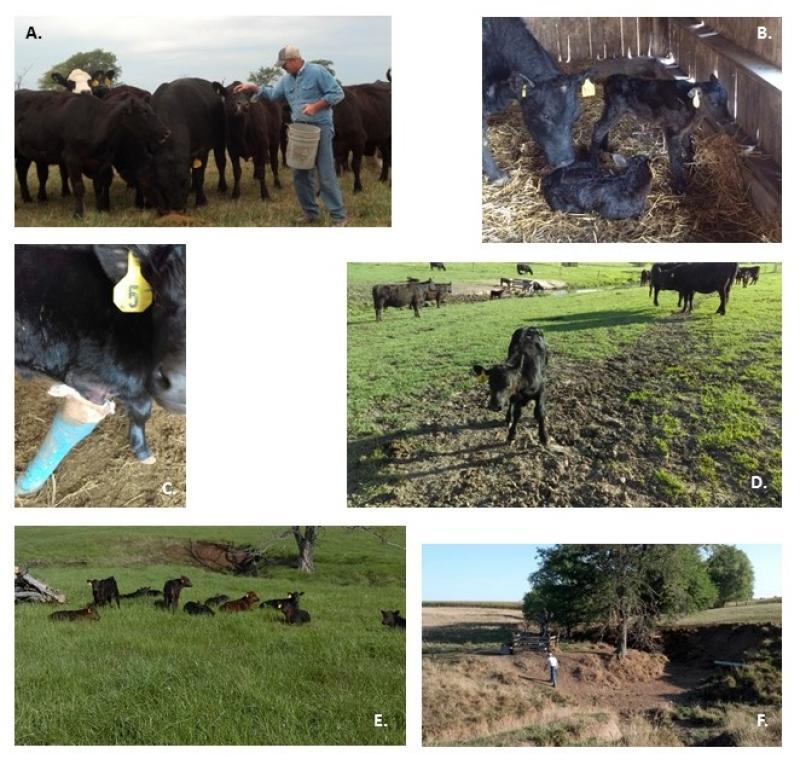May was Beef Month!

Have you fired up your grill this year? Chances are that you have, as summer is just around the corner. While grilling hamburgers or steaks, have you ever thought about where that beef was from, prior to its life on the grocery store shelf? May was ‘Beef Month’, and a great opportunity to break out your favorite beef recipes, and to reflect on the hard work of cattle farmers and ranchers that enable us to enjoy beef.
There are over 700,000 cattle farms and ranches in the U.S. that raise more than 30 million beef cows per year2, making the U.S. the world’s largest beef producer1. Texas has the largest cattle operation with 12.3 million head of cattle, followed by Nebraska (6.45 million) and Kansas (6.4 million)2. My dad and uncle are cattle farmers in central Illinois, and they raise ~40 head of Black Angus cattle (Fig. 1A), which is the average size of a U.S. cattle farm2.
There are generally 2 kinds of beef cattle operations: cow-calf productions and cattle feedlots. As the name suggests, cow-calf operations breed cows so that the calves become replacements to the herd after cattle are sold for beef production. The cattle raised on these farms are fed mainly on pasture1. The cattle raised in cattle feedlots are weaned from a pasture diet and fed a 70-90% grain-based diet for 90-300 days1. The grain-based diet causes a dramatic weight gain of 2.5 - 4 pounds per day, which is usually quicker than the weight gain of purely pasture-fed cattle. More information on the goals of cow-calf vs. cattle feedlots can be found here. Cattle are then sold for beef production on a $/lb. or $/100 lb. scale.
While there are different types of cattle operations, it is important to note that regardless of how cattle are raised, beef farmers work hard to produce a quality, healthy and ethical product. For example, no antibiotics are administered to the cattle on our farm, because if cattle are given medication, their beef may not be suitable for human consumption. Beef can be enjoyed daily because it is an excellent source of more than 10 essential nutrients, including iron and protein3.
So what does a cattle farm look like? Before I describe some of our farm specifics, I will first define a few terms:
Heifer: a female cow that has never given birth. Once she has a calf, she becomes a cow.
Steer: a male that has been neutered
Bull: a male that is used for breeding
On our farm, breeding is timed so that the calving season does not overlap with planting field crops, as my family also farms corn and soybeans. To ensure that calving season is finished before corn or soybean crops are planted, mating begins during the first week of June, when the bull is turned into the pasture to mate with the cows or heifers. If more than one bull is used for mating, they become aggressive with one another, so they must be separated into different pastures.
Calving season begins about 10 months later at the beginning of March, and lasts for 2 months. This year, we had 37 cows have calves. During one very busy week, 14 calves were born! All cows must be assessed daily for signs of labor, and if a cow goes into labor before dark, my family will check on her during the night to see how her labor is progressing. If her labor is progressing normally and the weather is not too cold, she will have her calf outside. If it is bitterly cold or if the cow is having a complicated labor, they will bring her into the barn to give birth.
One problem a cow might have while giving birth is that the calf is not positioned correctly in the uterus. Calves are born with the front feet first, but sometimes the front feet may be tucked underneath the body. In extreme cases, the calf may be faced completely backwards, which is dangerous for the calf. If a calf is born backwards, the umbilical cord will break after the hips exit the body, and the calf will begin breathing in placental fluid. During these situations, it is important to bring the cow into the barn and either help her re-position the calf, or in extreme cases, help pull the calf.
Once a calf is born, my dad makes sure the calf is breathing. Sometimes he will have to help the cow remove the placenta from the calf’s head, or the calf will suffocate. Then it is important to let the cow begin bonding with the calf immediately. Each calf will get an ear tag that is numbered so that it can be tracked during the course of its life (Fig. 1C). The umbilical cord is cleaned with iodine to help prevent infection, and if it is a male they will neuter it if they intend to sell it as a steer.
If a cow gives birth to twins (Fig. 1B), the cow often will not claim one of the calves. In this situation, newly born calves have to be bottle-fed daily until they begin feeding on the pasture. This season we had one set of twins, and even though the cow claimed both calves, the calves were separated because it is difficult for one cow to produce enough milk for 2 calves.
This year there was one cow that accidently stepped on her calf after giving birth, and she broke the calf’s leg. The veterinarian put a cast on the calf’s leg so that it could heal (Fig. 1C). The leg healed and the calf was able to join the other cows in the pasture (Fig. 1D).
About 6-8 months after the calves are born, they are fed a grain-based diet of corn, and they are also given free access to feed on hay. During this time, the calves will gain up to 4 pounds per day. The cattle will go to market when they are 14-16 months old, weighing about 1300 pounds. Heifers and steers are sold because they generally make the best quality beef. The cows are retained on the farm in the herd.
While calving season is very busy, there is still a lot of work that goes into daily cattle care. For example, cattle are fed daily, and the manure is removed from the barn areas when too much builds up. During drought years, the creek that runs through the pasture sometimes dries up completely, and my dad will have to pump water from the well (Fig. 1F), or sometimes haul water from another location so that the cattle can drink.
I hope this article provided some insight into the daily life of cattle farming! Now we will all be a little more appreciative of that beef on the grill.
Figure 1. Life on a cattle farm.

A. My dad with the cows and bull in the pasture. B. A cow with newly born twins. C.-D. A calf with a broken leg that is eventually turned into the pasture with the other cows. E. Calves in the pasture. F. A completely dried up creek during a drought year.
Written by TPS fellow Ashley Yates
References:
1. https://www.ers.usda.gov/topics/animal-products/cattle-beef/sector-at-a-glance/
2. http://www.beefusa.org/beefindustrystatistics.aspx
3. https://www.nebeef.org/Media/NEBeef/Docs/beef-nutrition-qa.pdf
